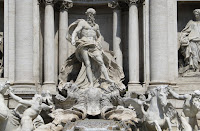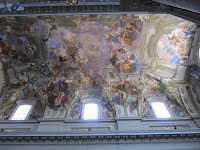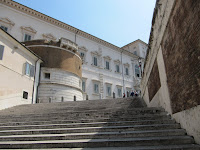Wednesday, 21 April 2010
I cover a lot of territory today, so this entry will be a little longer than usual, especially since it’s so much easier to include photographs when I do this at home. On board the Eurodam, uploading pictures ate up a good deal of web time, which in turn ate up a good deal of money. And this is a good way to test my short-term memory and keep a long-term record of the highlights of the trip.
Transportation in Rome
Public transit in Rome has become much more efficient for tourists since my last visit 20 years ago. The Metro is equipped with new, faster trains and much clearer signage. Most importantly, the long escalators at stations are actually working (it’s a very long way down and even longer back up). Bus and tram lines (the few trams lines in Rome run mostly from Termini to southern, less-touristy parts of the city) use new equipment and seem to be free of the ubiquitous pick-pockets of years gone by. Bus routes are clearly marked and one-, two-, and three-day passes—good on trains, buses, and trams—can be purchased quite cheaply at newsstands. The pass is really useful, allowing me to sit and ride even for relatively short distances.

Morning Sightseeing
• Fontana di Trevi and Quirinale
It’s a very short walk from the hotel to Termini Metro station and then two stops to Bernini, the closest station for exploring the Fontana di Trevi and Quirinale areas. The Incrocio della Quattro Fontane (Four Fountains Crossroad) was created in the late 16th century to facilitate traffic flowing to all parts of the city and to allow for pleasant vistas in four directions. Each corner of the intersection is canted at a diagonal to allow room for four complementary 16th-century fountains. This morning the intersection hums with vehicular and pedestrian traffic—but at least there is a traffic light to help keep things moving. Back in 1990 Will and I witnessed a very minor rear-end traffic bump between an expensive luxury sedan and a beat up jalopy that because of the stubbornness of the drivers escalated into a major multi-car catastrophe. Today things are much quieter and I am able to maneuver across the street into the cool interior of the church of San Carlo alle Quattro Fontane.
The exterior is considered Borromini’s finest work. He designed the building in 1638, but the façade, a complex organization of contrasting convex and concave surfaces, wasn’t completed until 1668, one year after his suicide. The interior is small and perfectly suited to the design, with a brilliantly coffered dome. Most Baroque structures have unadorned exteriors, with the blending and contrast of architectural lines providing the only decoration. The surprise for the visitor occurs when he steps inside to a riot of color and texture. San Carlo is an exception, with the monochrome of the exterior matched by most of the interior, except for the striking contrast of the dome.
Still further down, beyond a small park on the south side of the street and the long arm of the Palazzo del Quirinale (now a government building) on the north side, sits the large open space of the Piazza del Quirinale. And a short walk downhill from here leads to the Fontana di Trevi—after the Colosseum, probably the best-known icon of Rome. And after the Piazza di Spagna, definitely the busiest gathering place in Rome. It’s far too familiar to require any words of description.

• Classical Rome: The Pantheon
It’s literally a hop, skip, and jump from the Trevi Fountain to the busy Via del Corso, which bisects the city from Piazza di Popolo on the north to the Vittoriano Monument and the ruins of the Forum on the south; and another hop from the ruckus of the Corso to the quiet of Piazza Sant’Ignazio, one of my favorite spots in Rome, and the inspiration for many stage sets of period and Classical plays. Sitting on the steps of the Jesuit church of Sant’Ignazio, on the south side of the piazza, is like being in an open-air theatre.
But the best part of the performance is behind me in the church interior, with stunning trompe-l’œil ceiling frescoes by Andrea Pozzo (1684). A large mirror, placed at an angle on the floor of the nave, allows for close-up examination of the ceiling without excessive neck strain.


A pedestrians-only lane leads past the “Porter’s Fountain” to Piazza della Minerva and its statue of an elephant topped by an Egyptian obelisk from the 6th century BC.

The piazza is home also to Santa Maria sopra Minerva, a church with many important works of art—the most notorious being a marble statue of the “Risen Christ” by Michelangelo, with its private parts covered by a bronze loincloth added by Baroque prudes of a later generation. The frescoes here are by Filipino Lippi (1489-93), and there is an exuberant monument to Venerable Sister Maria Raggi by Bernini (1643).

The culmination of this short walk is the Piazza della Rotonda and the Pantheon itself. The most fascinating aspect of the building is the changing light and shadow that enters through the enormous oculus at the top of the dome. The present building was constructed in AD 117-38 on the foundations of an earlier temple destroyed by fire. The magnificent dome survived through the Middle Ages, but its architecture and technique were completely lost. It was only when Renaissance artists—including Bramante and Michelangelo—studied the dome themselves that the lost art was re-discovered. This stimulated the building of the great domes of the later Roman churches, including St Peter’s.
Afternoon Sightseeing
• Piazza Navona
After a long lunch (described further below), nearby Piazza Navona and its environs is next on my agenda. The huge plaza, with its three monumental fountains, was originally the site of Domitian’s stadium (AD 86), and its shape and form clearly reveal those origins, as does the small piece of remaining stonework hidden away around a corner. Today it is another popular gathering place, especially in the evenings when the fountains are lighted and the cafés are busy. The central “Fountain of the Rivers,” by Bernini (1651) is undergoing reconstruction and repairs, but most of it is still visible behind the fences and barriers. The smaller “Fountain of the Moor” on the south end and “Fountain of Neptune” on the north provide the necessary Baroque symmetry of design.

There are two important churches on the western side: Sant’Agnese in Agone, directly centered on the west side of the piazza, and Santa Maria della Pace, behind the northwest quadrant. On the eastern side the highlights are the Palazzo Massimo, with its painted façade, and Sant’Ivo alla Sapienza, which provides a convenient passageway through it cloisters. This passage leads back to the Piazza della Rotonda (see above), where I stop for gelato at a café with a view of the Pantheon—and some shrubbery hiding the McDonald’s next door.


• Castel Sant’Angelo
The late afternoon and early evening is taken up entirely by the Castel Sant’Angelo and the streets leading to it. The walk begins at the adjoining buildings of the Oratorio dei Filippini, with its lovely clock tower, and the Chiesa Nuova, with another wonderful ceiling fresco and three early Rubens paintings.

On Via Giulia, the Palazzo Sacchetti houses the headquarters of the anti-Mafia police, and other Renaissance buildings now serve as antique shops and restaurants. Then the statue-lined Ponte Sant’Angelo leads across the Tiber to the Castel itself.
Because today (21 April) is a public holiday celebrating the founding of Rome, free admission is offered to all sites administered by the government. It also explains why the city seems to be overrun with pushy student tour groups grinding the pavement in all the churches and galleries. Castel Sant’Angelo’s interior starts with a long ramp, wide enough for several carriages, winding to the top, from where there are excellent views in all directions (as well as a small café). After taking lots of pictures I catch Express Bus #40, which, despite early evening traffic, whizzes me back to Termini and my hotel.

Food
• Fixed-price lunch (€10,00): Di Rienzo, with a view of the circular wall of the Pantheon, provides excellent cannelloni, a fresh mixed green salad, sparkling water, and cappuccino (extra charge).
• Dinner: Alessio, another recommendation near my hotel. Located down a flight of stairs, the rustic restaurant offers no views, but the food is good and reasonably-priced: an excellent palliard of veal (grilled veal steak), superb fried potatoes and a lovely mixed salad, along with a half-bottle of Poggio Stella Montepulciano (2007). And a complementary iced limoncello to top it all off.



More to come: my final day in Rome and the long journey home.






















__03.jpg)